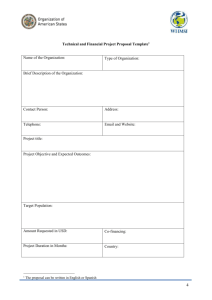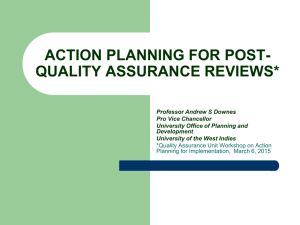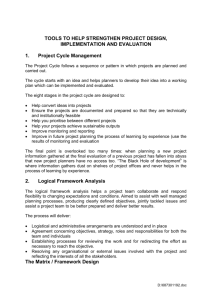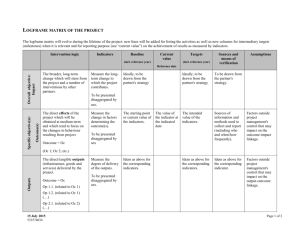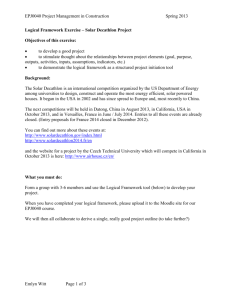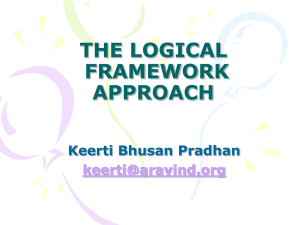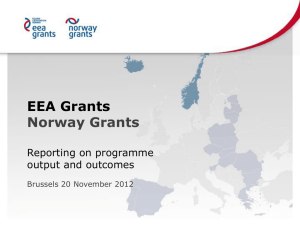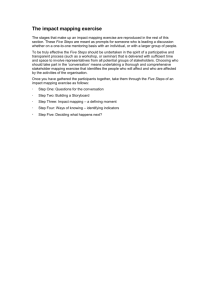Annual Programme Report template
advertisement
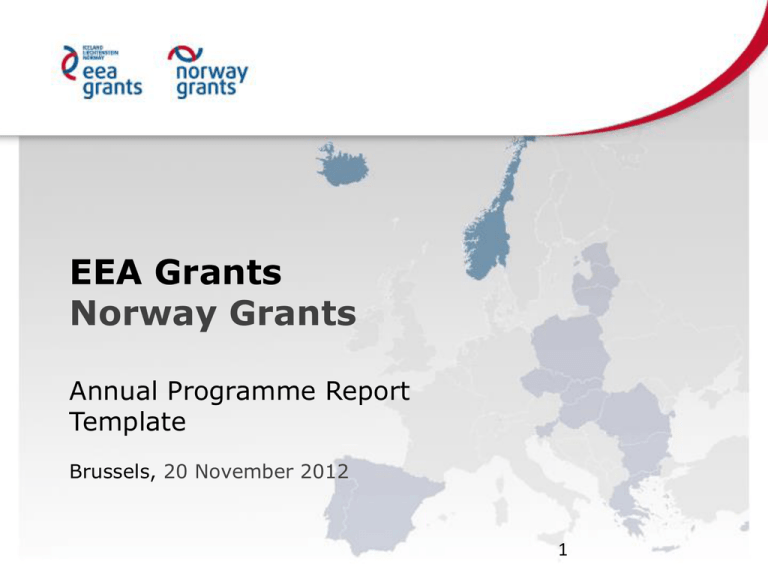
EEA Grants Norway Grants Annual Programme Report Template Brussels, 20 November 2012 1 Timeline January Donors reports to EFTA FMO Status Report PO Annual Programme Report 15 February NFP Strategic Report 31 March NMFA Annual Report to Parliament FMO compile annual report based on programme reports and strategic reports July Donors annual report Annual Programme Report • The main body of the report should not exceed 20 pages, excluding any attachments. 3 1. Executive summary • This section shall provide a short summary of the principal findings and points of the report. 4 2. Programme area specific developments Describe important developments in the Programme area, also in respect of policy, financial or administrative changes. If possible, add and analyse statistical trends 5 3. Reporting on outputs • Give a summary and analysis of how the selected projects have contributed or are contributing to each of the Programme outputs set out in the Programme proposal. • Analyse progress towards the defined outputs, and explain any deviation from the plan. Use the indicators that have been set to verify progress. If any reviews of projects have been undertaken, these shall also be used to verify progress. Use examples to illustrate and show progress. Focus on the most important results at output level. 6 Reporting on outputs 3.2 Give a summary of the implementation of each pre‐defined project. When projects have been completed give a summary of their actual contributions to the output targets. 3.3 Give a summary of the implementation of small grant schemes. If this is a Final Report, provide a summary of their actual contributions to the Programme output. 7 Example Output: Increased inter-municipal and inter-sectoral cooperation in planning and implementation of social and economic development strategies between local governments participating in the Project. Indicators: 1. Number of strategies developed in accordance with the model of intermunicipal and inter-sectoral cooperation 2. Number of social and private partners who participated in consultations on the strategy by formulating opinions/conclusions concerning planned measures 8 4. Reporting on Programme outcome • Analyse how the projects and the Programme’s outputs contribute to the expected outcome(s) defined in the Programme proposal. • Use the indicators that have been set to verify progress. If the Programme has been subject to a review, this shall also be used to verify progress. Focus on the most important results at the outcome level. • Refer to baseline studies • Refer to qualitative surveys, studies etc. • Assess the use of indicators 9 Example Outcome: Regions and urban areas are cooperating in the fields of public and private services, business development and innovation, to stimulate social and economic development Indicators: 1. Number of measures promoting cooperation and economic development between urban and rural institutions. 2. Number of partnerships between self-government units and between local authorities and representatives of the NGO sector and business 3. Number of institutions with strengthened capacity 10 5. Project selection • With reference to the Programme proposal list the calls carried out during the reporting period. Include a summary of the call(s) and describe the level of interest. 11 6. Progress of bilateral relations • Give a summary of how partnerships between the Beneficiary States and the Donor State(s) have been facilitated during the reporting period. 12 7. Monitoring • Describe the monitoring activities that have been carried out and give a summary of the findings. • Provide a monitoring plan for the next reporting period. 13 8. Need for adjustments • If the Programme Operator has made use of a possibility to modify the Programme in line with Article 5.9 of the Regulations and the Programme Agreement during the reporting period, the modifications shall be described in this section. 14 9. Risk management • With reference to the risks identified in the Programme proposal, give an analysis of the situation and any mitigating actions carried out or planned. If any new risks have been identified, then they shall also be discussed in this section. • Be aware of the Risk management strategy of the Donors. The Donors expect similar strategies to be elaborated in each Beneficiary State. • A Corruption risk assessment tool will be applied with TI to each Programme to assist in the identification of programmes at risk. 15 10. Information and publicity • With reference to the Communication Plan provided in the Programme proposal give a summary of the activities carried out during the reporting period. 16 • Examples of planned communications events? 17 11. Cross‐cutting issues • Describe how the Programme has performed (positively or negatively) in relation to the three crosscutting issues (ref. Chapter 3.11 in this Manual), and which measures, if any, that have been put in place to improve performance. 18 12. Reporting on sustainability • If this is a Final Report, provide an assessment of the extent to which the positive effects of the Programme will continue after the funding period. 19 13. Attachment to the Annual Programme Report • Monitoring Plan 20 14. Attachment to the Final Programme Report • Financial annex 21 Questions 22
